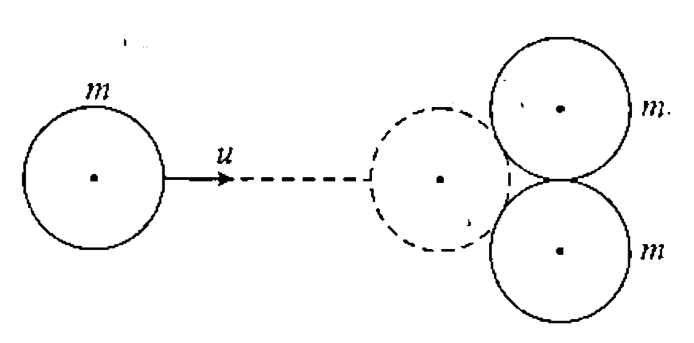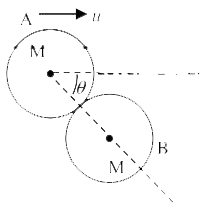Consider 3 identical balls, each having mass of 0.1 kg. The ball A has an initial velocity of 10√3m/s. It then collides simultaneously with balls B and C, whose centres are on a line perpendicular to the initial velocity of the ball A. They are initially in contact with each other and are at rest. The ball A is aimed directly at the contact point of B and C. After the collision, if the ball A comes to rest, then
Collision in elastic.
Collision is inelastic and final kinetic energy of the system-Initial kinetic energy of the system = 5J
Collision is inelastic and final kinetic energy of the system - Initial kinetic energy of the system = - 5J
Collision in elastic, but the final kinetic energy of the system is less than the initial kinetic energy of the system.
The correct Answer is:C
Topper's Solved these Questions
- KINEMATICSBOOK - FIITJEECHAPTER - KINEMATICSEXERCISE - MCQ (MULTIPLE CORRECT)
15 Videos
- KINEMATICSBOOK - FIITJEECHAPTER - KINEMATICSEXERCISE - ASSERTION-REASON MCQ ( SINGLE CORRECT)
8 Videos
- KINEMATICSBOOK - FIITJEECHAPTER - KINEMATICSEXERCISE - SECTION (II) : (SUBJECTIVE )
33 Videos
- HEAT AND TEMPERATUREBOOK - FIITJEECHAPTER - HEAT AND TEMPERATUREEXERCISE - NUMERICAL BASES QUESTIONS
1 Videos
- LAWS OF MOTIONBOOK - FIITJEECHAPTER - LAWS OF MOTIONEXERCISE - COMPREHENSION-III
2 Videos
Similar Questions
A ball with initial speed of10m/s collides elastically with two other identical balls at rest as shown in figure, whose centres are on a line perpendicular to the initial velocity and which are initially in contact with each other.All the three balls are lying on a smooth horizontal table. The first ball is aimed directly at the contact point of the other two balls.All the balls are smooth. Find the velocities of the three balls after the collision.

View SolutionA ball A of mass M collides elastically with a similar ball B at rest as shown in figure. Initially velocity of ball A is u m/s. After collision,

View Solution
Knowledge Check
A ball A of mass M collides elastically with a similar ball B at rest as shown in figure. Initially velocity of ball A is u m/s. After collision,
 ASpeed of ball B is u sinθBVelocity of ball A is usin2θˆi+usinθcosθˆjCSpeed of ball A is ucosθDVelocityofballBisu cos theta sin theta hati + u cos^2 theta hatj
ASpeed of ball B is u sinθBVelocity of ball A is usin2θˆi+usinθcosθˆjCSpeed of ball A is ucosθDVelocityofballBisu cos theta sin theta hati + u cos^2 theta hatjA ball thrown vertically upwards with an initial velocity of 1.4m/s. The total displcement of the ball is
A22.4cmBzeroC44.8mD33.6mA ball of mass moving with a velocity u collides head on with a ball B of mass m at rest. If the coefficient of restitution is e. the ratio of final velocity of B to the initial velocity of A is
A1−e1+eB1+e1−eC1+e2D1−e2
A ball thrown vertically upwards with an initial velocity of 1.4m/s. The total displcement of the ball is
View SolutionThe ball A collides elastically with an identical ball B with a speed v. The ball B touches another identical ball C. The velocity of C, after the impact, is equal to

View SolutionThe ball A collides elastically with an identical ball B with a speed v. The ball B touches another identical ball C. The velocity of C, after the impact, is equal to

View SolutionA ball thrown vertically upwards with an initial velocity of 1.4 m/s returns in 2s. The total dispalcement of the ball is
View SolutionThe first ball of mass m moving with a velocity u collides head on with the second ball of mass m at rest. If the coefficient of restitution is e, the ratio of final velocity of the second ball to the initial velocity of the first ball is
View Solution
